Study on the Evolution of Landscape Patterns in Industrial Cities Based on the Evaluation of Ecological Security Levels—A Case Study of Haining City
Abstract
1. Introduction
2. Materials and Methods
2.1. Overview of the Study Area
2.2. Research Methods
2.2.1. Data Sources and Preprocessing
2.2.2. Land Use Change Method
2.2.3. Landscape Pattern Indices
2.2.4. Ecological Security Evaluation
- Selection of Ecological Security Evaluation Indicators
- 2.
- Determination of Landscape Ecological Security Standards
2.2.5. Spatial Autocorrelation Analysis
3. Results
3.1. Analysis of Land Use Change
3.1.1. Current Situation of Land Use
3.1.2. Land Use Structure Change
3.2. Analysis of Landscape Pattern Change
3.2.1. Patch-Scale Change Analysis
3.2.2. Landscape-Scale Change Analysis
3.3. Evolution of the Landscape Ecological Security Pattern
3.3.1. Overall Pattern of the Landscape Ecological Security Index
3.3.2. Spatial Autocorrelation Analysis of the Landscape Ecological Security Index
4. Discussion
4.1. Driving Mechanism and Causal Relationship of Land Use Change on Landscape Pattern Evolution
4.2. Ecological Security Regulation and Planning of Haining
Ecological Security Zoning Plan of Haining
4.3. Implications for the Planning and Development of Industrial Cities
4.4. Limitations and Future Directions
5. Conclusions
- (1)
- Rapid industrialization and urban construction activities significantly drove the conversion of farmland into urban–rural residential construction land, which in turn led to landscape fragmentation, reduction of ecological patches, and decreased landscape connectivity. The overall stability and recovery capacity of the ecosystem were negatively disturbed by human activities, and the regional ecological security pattern evolved from stability to a fluctuating trend of ecological risks.
- (2)
- From 1980 to 2020, the evolution of Haining’s landscape pattern demonstrated the typical characteristics of a rapidly industrializing city. At the patch scale, most land types, except for farmland, exhibited trends of high fragmentation, simplified morphology, and declining ecological stability, while farmland and water areas maintained their dominant positions and leading roles. At the landscape scale, the diversity of landscape types increased, and both fragmentation and contagion indices decreased, indicating that the spatial organization of land use was gradually optimized. These changes correspond to the implementation of land management policies and ecological governance measures at different stages, suggesting that policy interventions can substantially enhance regional ecological security. Based on this case study, similar industrial cities aiming to improve their ecological security levels should take blue-green corridors and ecological core patches as the structural framework to limit the fragmentation of conversion corridors for construction land while prioritizing cross-regional connectivity and the continuity of riparian buffer zones to strengthen regional ecological security. It is particularly important to enhance the spatial connectivity of landscape patterns in industrial cities, as such connectivity plays a key role in supporting ecological optimization processes, mitigating habitat isolation, and promoting sustainable urban development.
- (3)
- According to the overall ecological security evaluation, spatial autocorrelation analysis, and the identification of clustering characteristics, the overall ecological security planning of Haining should be divided into four regulation zones: key ecological restoration zones, ecological pattern optimization zones, ecological function protection zones, and green development guidance zones. Combined with the land use characteristics, patch properties, and regional industrial layout of different ecological regulation zones, differentiated regulation strategies were proposed, including restricting disorderly urban expansion, strengthening ecological buffer zone construction, and promoting regional industrial transformation. This analytical and identification method can provide theoretical and empirical support for ecological security governance in industrial cities.
- (4)
- From the perspective of spatial structure and ecological function, this paper deepened the correlation mechanism among “land use—landscape pattern—ecological security,” and constructed an evaluation framework suitable for regulating ecological security risks during the transformation of industrial cities worldwide. Furthermore, this evaluation system can not only diagnose urban ecological vulnerable zones and potential risk zones but also provide a scientific basis for government departments to formulate spatial planning policies for ecological zoning control, with strong operability and practical guidance value.
Author Contributions
Funding
Data Availability Statement
Acknowledgments
Conflicts of Interest
Appendix A
| Unit: ha | ||||||||
|---|---|---|---|---|---|---|---|---|
| 2020 | Grassland | Farmland | Industrial and Mining Land | Urban and Rural Residential Land | Woodland | Waters | Total | |
| 1980 | ||||||||
| Grassland | 6.49 | 0 | 0.35 | 13.31 | 1.12 | 6.97 | 28.24 | |
| Farmland | 0 | 422.45 | 10.63 | 83.81 | 0.71 | 6.53 | 524.13 | |
| Industrial and Mining Land | 0 | 0.38 | 3.67 | 0.69 | 0.08 | 0 | 4.82 | |
| Urban and Rural Residential Land | 0 | 0.38 | 0 | 143.11 | 0 | 0.22 | 143.71 | |
| Woodland | 0 | 0 | 0.21 | 0.16 | 10.57 | 0.25 | 11.18 | |
| Waters | 2.17 | 4.43 | 2.36 | 5.51 | 0 | 140.94 | 155.41 | |
| Total | 8.66 | 427.65 | 17.22 | 246.59 | 12.46 | 154.91 | 867.49 | |
Appendix B
| Uni: ha | |||||||||
|---|---|---|---|---|---|---|---|---|---|
| 1990 | Grassland | Farmland | Industrial and Mining Land | Unused Land | Urban and Rural Residential Land | Waters | Woodland | Total | |
| 1980 | |||||||||
| Grassland | 0 | 0.36 | 0 | 0 | 0 | 26.36 | 1.24 | 28.23 | |
| Farmland | 516.68 | 0 | 0 | 0 | 4.34 | 2.37 | 0.71 | 524.13 | |
| Industrial and Mining Land | 2.29 | 0 | 2.02 | 0.04 | 0.38 | 0.01 | 0.09 | 4.82 | |
| Urban and Rural Residential Land | 2.81 | 0 | 0 | 0 | 132.15 | 8.74 | 0 | 143.71 | |
| Waters | 6.41 | 0 | 0 | 0 | 0.54 | 148.41 | 0.05 | 155.40 | |
| Woodland | 0.45 | 0 | 0 | 0 | 0.01 | 0 | 10.73 | 11.18 | |
| Total | 528.64 | 0.36 | 2.02 | 0.04 | 137.46 | 186.15 | 12.80 | 867.48 | |
Appendix C
| Unit: ha | ||||||||
|---|---|---|---|---|---|---|---|---|
| 2020 | Farmland | Grassland | Industrial and Mining Land | Urban and Rural Residential Land | Waters | Woodland | Total | |
| 2010 | ||||||||
| Farmland | 427.65 | 6.16 | 4.66 | 57.55 | 0.75 | 0 | 496.77 | |
| Grassland | 0 | 0.33 | 0 | 0 | 0 | 0 | 0.333814 | |
| Industrial and Mining Land | 0 | 0 | 12.40 | 0 | 0 | 0 | 12.40 | |
| Urban and Rural Residential Land | 0 | 0 | 0 | 187.08 | 0.22 | 0 | 187.30 | |
| Waters | 0 | 2.16 | 0.17 | 1.20 | 153.94 | 0 | 157.47 | |
| Woodland | 0 | 0 | 0 | 0.76 | 0 | 12.46 | 13.22 | |
| Total | 427.65 | 8.66 | 17.22 | 246.59 | 154.91 | 12.46 | 867.49 | |
References
- Qiong, L. An Index Evaluation for Planning Modern Industrial Cities: The Low Carbon Concept. Open House Int. 2017, 42, 15–19. [Google Scholar] [CrossRef]
- Rahman, M.M.; Alam, K.; Velayutham, E. Is Industrial Pollution Detrimental to Public Health? Evidence from the World’s Most Industrialised Countries. BMC Public Health 2021, 21, 1175. [Google Scholar] [CrossRef]
- Lu, X.; Wu, X.; Wang, Y.; Chen, H.; Gao, P.; Fu, Y. Risk Assessment of Toxic Metals in Street Dust from a Medium-Sized Industrial City of China. Ecotoxicol. Environ. Saf. 2014, 106, 154–163. [Google Scholar] [CrossRef]
- Zhou, M.; Li, X.; Zhang, M.; Liu, B.; Zhang, Y.; Gao, Y.; Ullah, H.; Peng, L.; He, A.; Yu, H. Water Quality in a Worldwide Coal Mining City: A Scenario in Water Chemistry and Health Risks Exploration. J. Geochem. Explor. 2020, 213, 106513. [Google Scholar] [CrossRef]
- Soltani-Gerdefaramarzi, S.; Ghasemi, M.; Ghanbarian, B. Geogenic and Anthropogenic Sources Identification and Ecological Risk Assessment of Heavy Metals in the Urban Soil of Yazd, Central Iran. PLoS ONE 2021, 16, e0260418. [Google Scholar] [CrossRef] [PubMed]
- Zhou, S.; Duan, Y.; Zhang, Y.; Guo, J. Vegetation Dynamics of Coal Mining City in an Arid Desert Region of Northwest China from 2000 to 2019. J. Arid Land 2021, 13, 534–547. [Google Scholar] [CrossRef]
- Cen, X.; Wu, C.; Xing, X.; Fang, M.; Garang, Z.; Wu, Y. Coupling Intensive Land Use and Landscape Ecological Security for Urban Sustainability: An Integrated Socioeconomic Data and Spatial Metrics Analysis in Hangzhou City. Sustainability 2015, 7, 1459–1482. [Google Scholar] [CrossRef]
- Wang, Y.; Wang, X.; Zhang, W.; Man, W.; Liu, M.; Jiao, L. Spatiotemporal Evolution of Landscape Ecological Risk and Its Driving Factors of the Beijing–Tianjin–Hebei Major Mineral Belt, 1985–2022. Sci Rep 2025, 15, 2425. [Google Scholar] [CrossRef]
- Nuissl, H.; Siedentop, S. Urbanisation and Land Use Change. In Sustainable Land Management in a European Context; Weith, T., Barkmann, T., Gaasch, N., Rogga, S., Strauß, C., Zscheischler, J., Eds.; Human-Environment Interactions; Springer International Publishing: Cham, Switzerland, 2021; Volume 8, pp. 75–99. ISBN 978-3-030-50840-1. [Google Scholar]
- Tang, Q.; Wang, J.; Jing, Z.; Yan, Y.; Niu, H. Response of Ecological Vulnerability to Land Use Change in a Resource-Based City, China. Resour. Policy 2021, 74, 102324. [Google Scholar] [CrossRef]
- Zhao, J.; Yu, Q.; Xu, C.; Ma, J.; Liu, W.; Sun, W.; Miao, Y.; Nawaz, T. Integrated Approach for Ecological Restoration and Ecological Spatial Network Optimization with Multiple Ecosystem Functions in Mining Areas. Ecol. Indic. 2023, 156, 111141. [Google Scholar] [CrossRef]
- Liang, X.; Li, Y.; Zhao, Y. Coupling Land Use Analysis and Ecological Risk Assessment: A Study of the Three Gorges Reservoir Area, China. Mt. Res. Dev. 2020, 40, R1. [Google Scholar] [CrossRef]
- Wang, D.; Ji, X.; Li, C.; Gong, Y. Spatiotemporal Variations of Landscape Ecological Risks in a Resource-Based City under Transformation. Sustainability 2021, 13, 5297. [Google Scholar] [CrossRef]
- Tian, Y.; Liu, B.; Hu, Y.; Xu, Q.; Qu, M.; Xu, D. Spatio-Temporal Land-Use Changes and the Response in Landscape Pattern to Hemeroby in a Resource-Based City. ISPRS Int. J. Geo-Inf. 2020, 9, 20. [Google Scholar] [CrossRef]
- Li, Y.; Duo, L.; Zhang, M.; Yang, J.; Guo, X. Habitat Quality Assessment of Mining Cities Based on InVEST Model—A Case Study of Yanshan County, Jiangxi Province. Int. J. Coal Sci. Technol. 2022, 9, 28. [Google Scholar] [CrossRef]
- Xu, L.; Yu, H.; Zhong, L. Sustainable Futures for Transformational Forestry Resource-Based City: Linking Landscape Pattern and Administrative Policy. J. Clean. Prod. 2025, 496, 145087. [Google Scholar] [CrossRef]
- Zhou, S.; Chang, J.; Luo, P.; Kang, Y.; Li, S. Landscape Dynamics and Human Disturbance Processes in Wetlands in a Mining City: A Case Study in Huaibei, China. Environ. Monit. Assess. 2023, 195, 192. [Google Scholar] [CrossRef]
- Dong, J.; Guo, Z.; Zhao, Y.; Hu, M.; Li, J. Coupling Coordination Analysis of Industrial Mining Land, Landscape Pattern and Carbon Storage in a Mining City: A Case Study of Ordos, China. Geomat. Nat. Hazards Risk 2023, 14, 2275539. [Google Scholar] [CrossRef]
- Zheng, W.; Guo, B.; Su, H.; Liu, Z. Study on Multi-Scenarios Regulating Strategy of Land Use Conflict in Urban Agglomerations under the Perspective of “Three-Zone Space”: A Case Study of Harbin-Changchun Urban Agglomerations, China. Front. Environ. Sci. 2024, 11, 1288933. [Google Scholar] [CrossRef]
- You, M.; Zou, Z.; Zhao, W.; Zhang, W.; Fu, C. Study on Land Use and Landscape Pattern Change in the Huaihe River Ecological and Economic Zone from 2000 to 2020. Heliyon 2023, 9, e13430. [Google Scholar] [CrossRef] [PubMed]
- Fan, Q.; Ding, S. Landscape Pattern Changes at a County Scale: A Case Study in Fengqiu, Henan Province, China from 1990 to 2013. CATENA 2016, 137, 152–160. [Google Scholar] [CrossRef]
- Wang, Y.; Zhao, X.; Zuo, L.; Zhang, Z.; Wang, X.; Yi, L.; Liu, F.; Xu, J. Spatial Differentiation of Land Use and Landscape Pattern Changes in the Beijing–Tianjin–Hebei Area. Sustainability 2020, 12, 3040. [Google Scholar] [CrossRef]
- Yao, J.; Xu, P.; Huang, Z. Impact of Urbanization on Ecological Efficiency in China: An Empirical Analysis Based on Provincial Panel Data. Ecol. Indic. 2021, 129, 107827. [Google Scholar] [CrossRef]
- Shen, H. Experience in industrial transformation of foreign old industrial cities. Macroecon. Manag. 2020, 1, 85–90. [Google Scholar] [CrossRef]
- Chen, Y.; Wang, H. Industrial Structure, Environmental Pressure and Ecological Resilience of Resource-Based Cities-Based on Panel Data of 24 Prefecture-Level Cities in China. Front. Environ. Sci. 2022, 10, 885976. [Google Scholar] [CrossRef]
- Wang, F.; Gu, N. Impact of Ecological Security on Urban Sustainability in Western China—A Case Study of Xi’an. Environ. Plan. B Urban Anal. City Sci. 2021, 48, 1314–1339. [Google Scholar] [CrossRef]
- Ye, J.; Guo, G.; Yu, K.; Lu, Y. Allocation Efficiency of Public Sports Resources Based on the DEA Model in the Top 100 Economic Counties of China in Zhejiang Province. Sustainability 2023, 15, 9585. [Google Scholar] [CrossRef]
- Yang, J.; Huang, X. The 30 m Annual Land Cover Dataset and Its Dynamics in China from 1990 to 2019. Earth Syst. Sci. Data 2021, 13, 3907–3925. [Google Scholar]
- Hu, Y.; Ma, Y.; Zhang, W. Land Use/Cover in China’s Land Areas: Spatio-temporal Pattern Change and Driving Forces Analysis. J. Agric. 2020, 10, 26–35. Available online: https://iac.iacademic.info/nxxb/EN/10.11923/j.issn.2095-4050.cjas20190600085 (accessed on 23 October 2025).
- Zhou, X.; Chu, Z.; Ji, X. Changes in the Land-Use Landscape Pattern and Ecological Network of Xuzhou Planning Area. Sci. Rep. 2024, 14, 8854. [Google Scholar] [CrossRef]
- Aguilera, F.; Valenzuela, L.M.; Botequilha-Leitão, A. Landscape Metrics in the Analysis of Urban Land Use Patterns: A Case Study in a Spanish Metropolitan Area. Landsc. Urban Plan. 2011, 99, 226–238. [Google Scholar] [CrossRef]
- Tian, S.; Zhang, Y.; Xu, Y.; Wang, Q.; Yuan, X.; Ma, Q.; Chen, L.; Ma, H.; Xu, Y.; Yang, S.; et al. Urban Ecological Security Assessment and Path Regulation for Ecological Protection—A Case Study of Shenzhen, China. Ecol. Indic. 2022, 145, 109717. [Google Scholar] [CrossRef]
- Lai, S.; Sha, J.; Eladawy, A.; Li, X.; Wang, J.; Kurbanov, E.; Lin, Z.; Wu, L.; Han, R.; Su, Y.-C. Evaluation of Ecological Security and Ecological Maintenance Based on Pressure-State-Response (PSR) Model, Case Study: Fuzhou City, China. Hum. Ecol. Risk Assess. Int. J. 2022, 28, 734–761. [Google Scholar] [CrossRef]
- Song, Z.; Zhu, N.; Yang, D.; He, D. Ecological Security Evaluation and Prediction for Coal Resource Cities Based on the PSR Model: A Case Study of Xuzhou, China. Sustainability 2024, 16, 8461. [Google Scholar] [CrossRef]
- Ye, A.; Li, X.; Cai, J.; Deng, Y. Evaluation of Water Ecological Security and Diagnosis of Obstacles in the Yangtze River Delta, China. Sci. Rep. 2025, 15, 30981. [Google Scholar] [CrossRef]
- Nitschke, C.R.; Innes, J.L. Integrating Climate Change into Forest Management in South-Central British Columbia: An Assessment of Landscape Vulnerability and Development of a Climate-Smart Framework. For. Ecol. Manag. 2008, 256, 313–327. [Google Scholar] [CrossRef]
- He, P.; Wang, L.; Zhai, S.; Guo, Y.; Huang, J. Assessment of Landscape Risks and Ecological Security Patterns in the Tarim Basin, Xinjiang, China. Land 2025, 14, 1221. [Google Scholar] [CrossRef]
- Xiong, H.; Hu, H.; Han, P.; Wang, M. Integrating Landscape Ecological Risks and Ecosystem Service Values into the Ecological Security Pattern Identification of Wuhan Urban Agglomeration. Int. J. Environ. Res. Public Health 2023, 20, 2792. [Google Scholar] [CrossRef] [PubMed]
- O’Neill, R.V.; Krummel, J.R.; Gardner, R.H.; Sugihara, G.; Jackson, B.; DeAngelis, D.L.; Milne, B.T.; Turner, M.G.; Zygmunt, B.; Christensen, S.W.; et al. Indices of Landscape Pattern. Landsc. Ecol. 1988, 1, 153–162. [Google Scholar] [CrossRef]
- Cumming, S.; Vervier, P. Statistical Models of Landscape Pattern Metrics, with Applications to Regional Scale Dynamic Forest Simulations. Landsc. Ecol. 2002, 17, 433–444. [Google Scholar] [CrossRef]
- Lin, X.; Wang, Z. Landscape Ecological Risk Assessment and Its Driving Factors of Multi-Mountainous City. Ecol. Indic. 2023, 146, 109823. [Google Scholar] [CrossRef]
- Gao, H.; Han, H.; Liu, Y.; Wang, T.; Bai, Y.; Ma, S.; Chen, S. Changes in landscape disturbance degree of steep slope land use in Guizhou Province from 1995 to 2015. J. Nanjing For. Univ. (Nat. Sci. Ed.) 2020, 44, 183–190. Available online: https://www.cabidigitallibrary.org/doi/full/10.5555/20220443903 (accessed on 23 October 2025).
- Wang, Q.; Tang, F.; Li, Y.; Huang, J.; Bai, X. Spatio-temporal differentiation of landscape pattern evolution and its ecological security in karst areas: A case study of trough valley in northeast Guizhou Province. Acta Ecol. Sin. 2021, 41, 7273–7291. [Google Scholar] [CrossRef]
- Wen, M.; Zhang, T.; Li, L.; Chen, L.; Hu, S.; Wang, J.; Liu, W.; Zhang, Y.; Yuan, L. Assessment of Land Ecological Security and Analysis of Influencing Factors in Chaohu Lake Basin, China from 1998–2018. Sustainability 2021, 13, 358. [Google Scholar] [CrossRef]
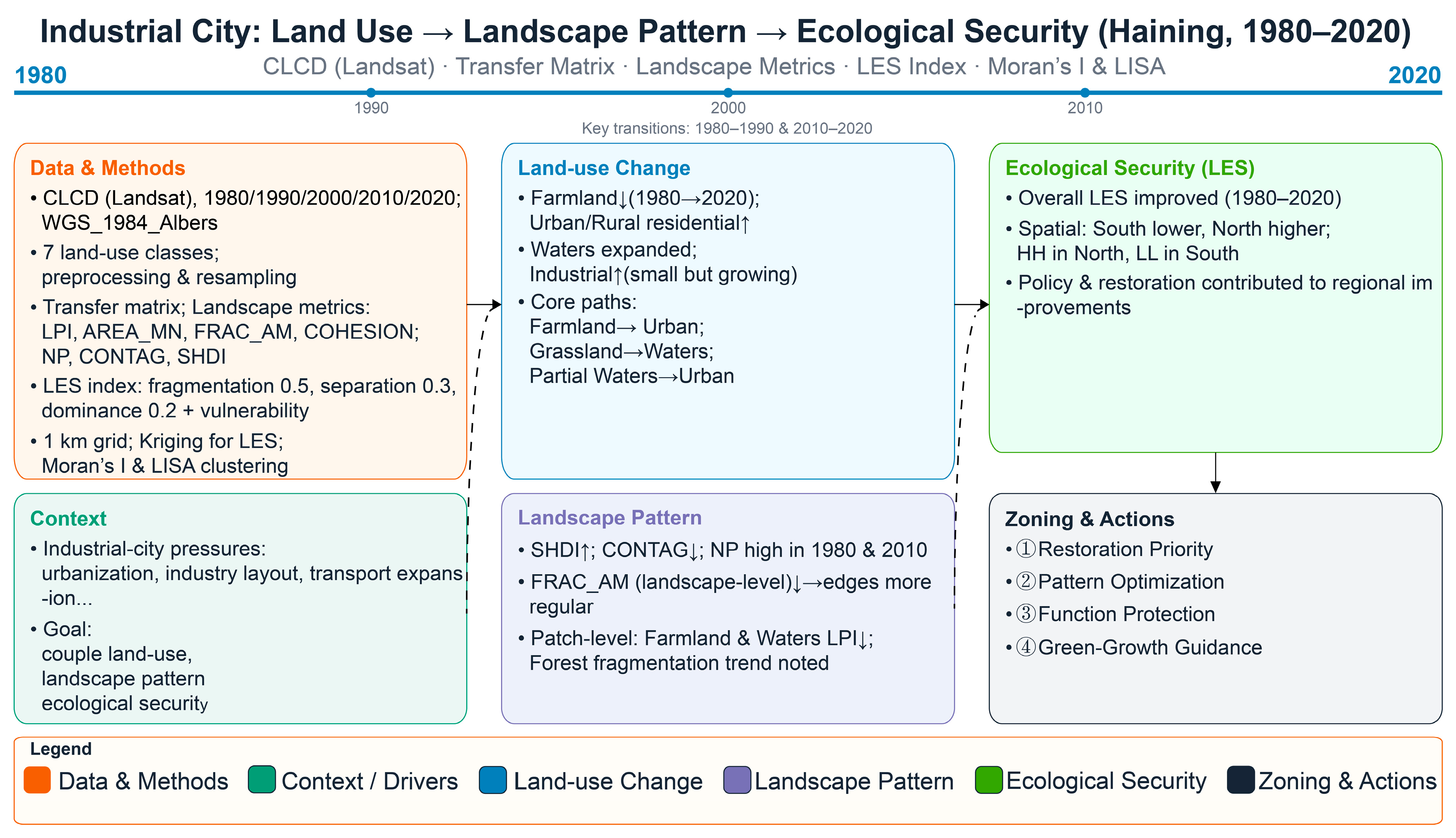
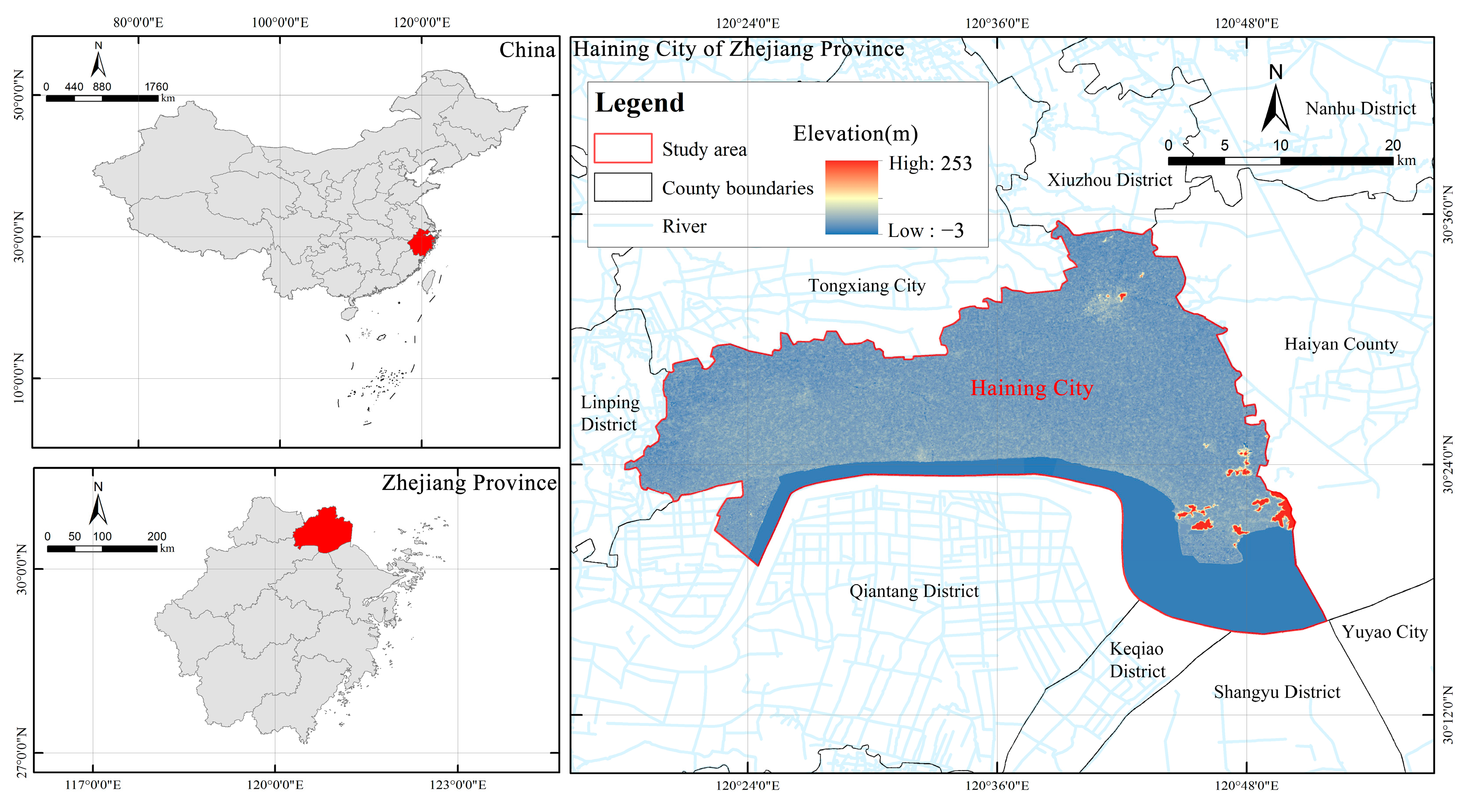
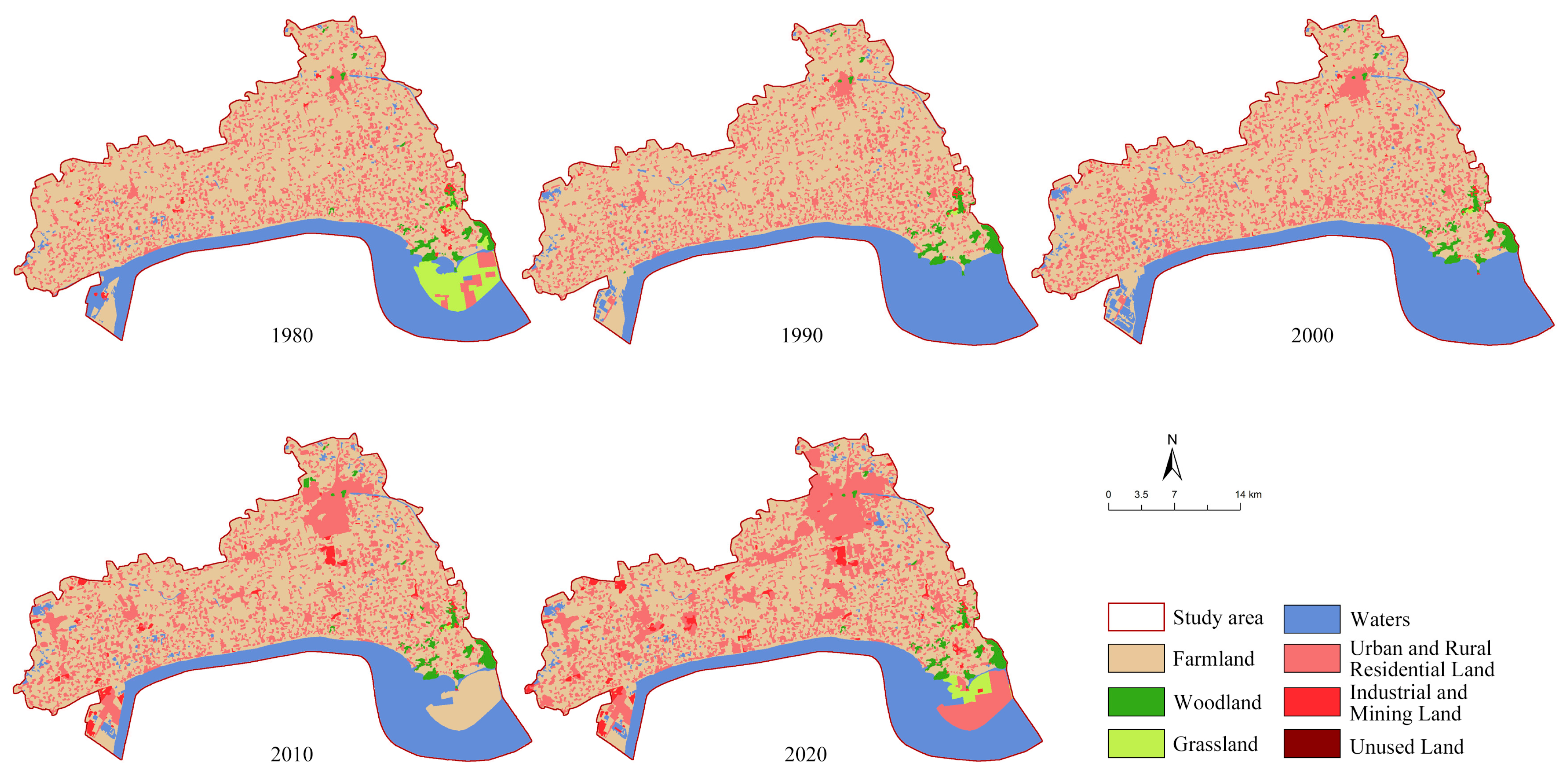
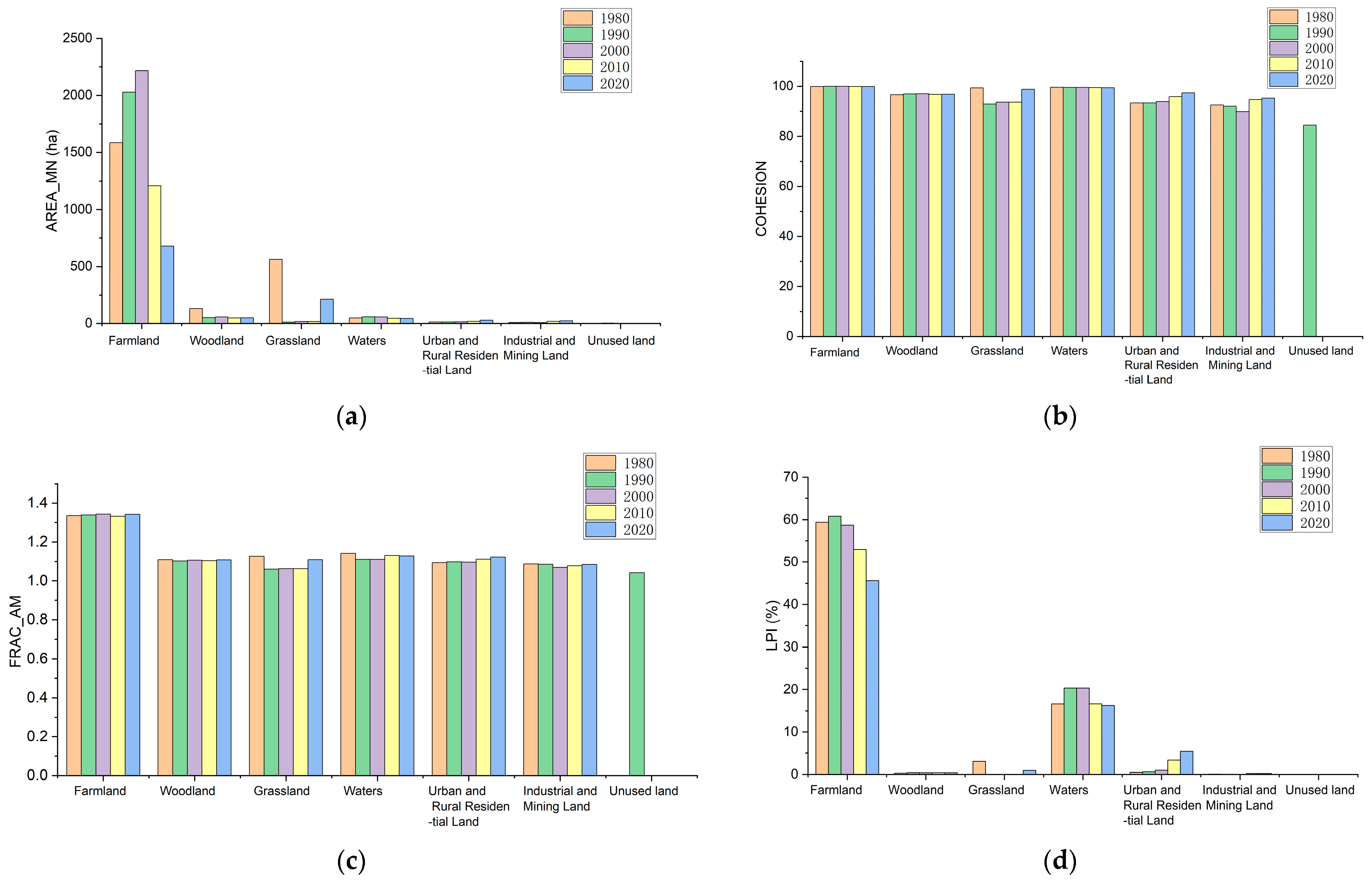
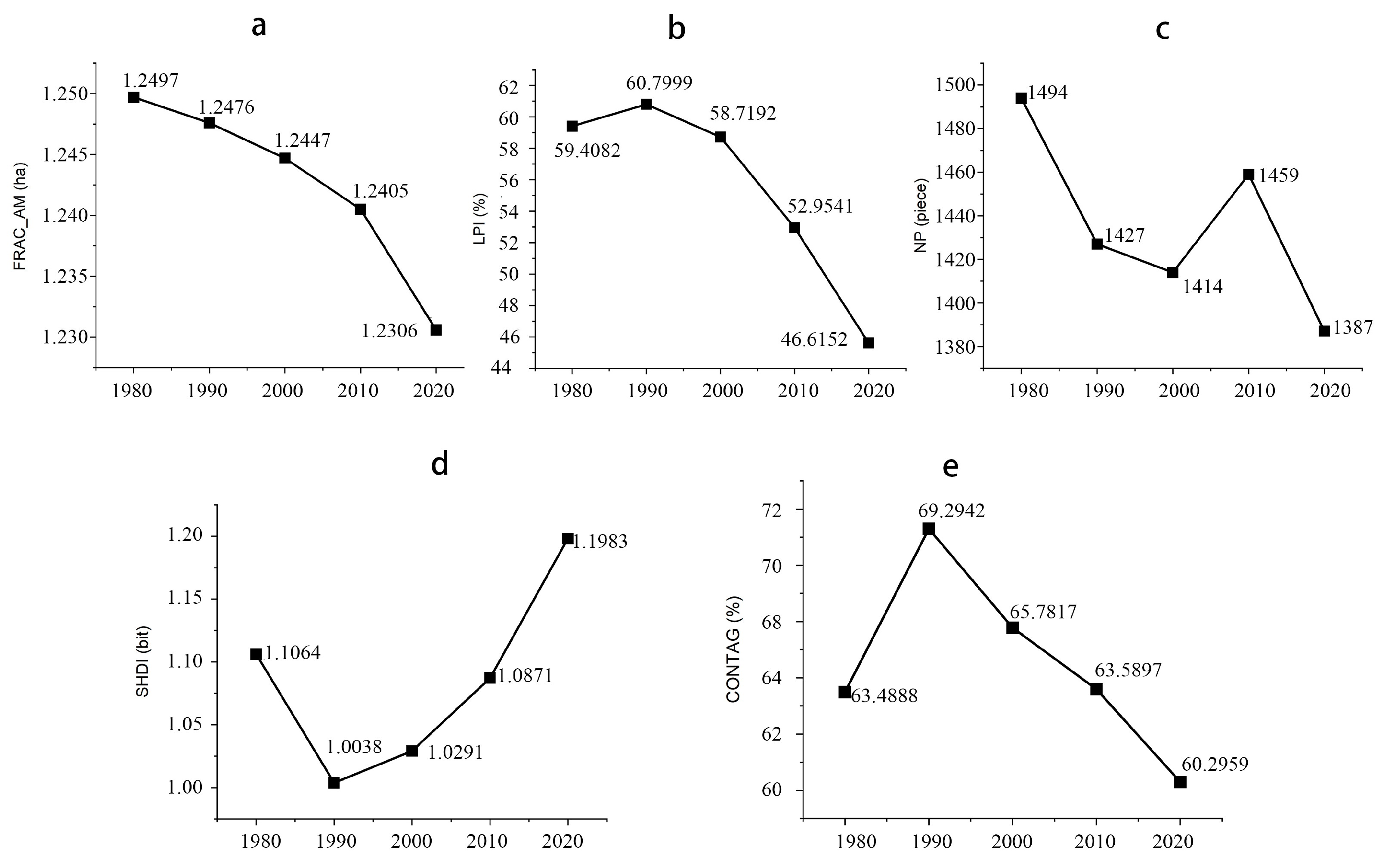

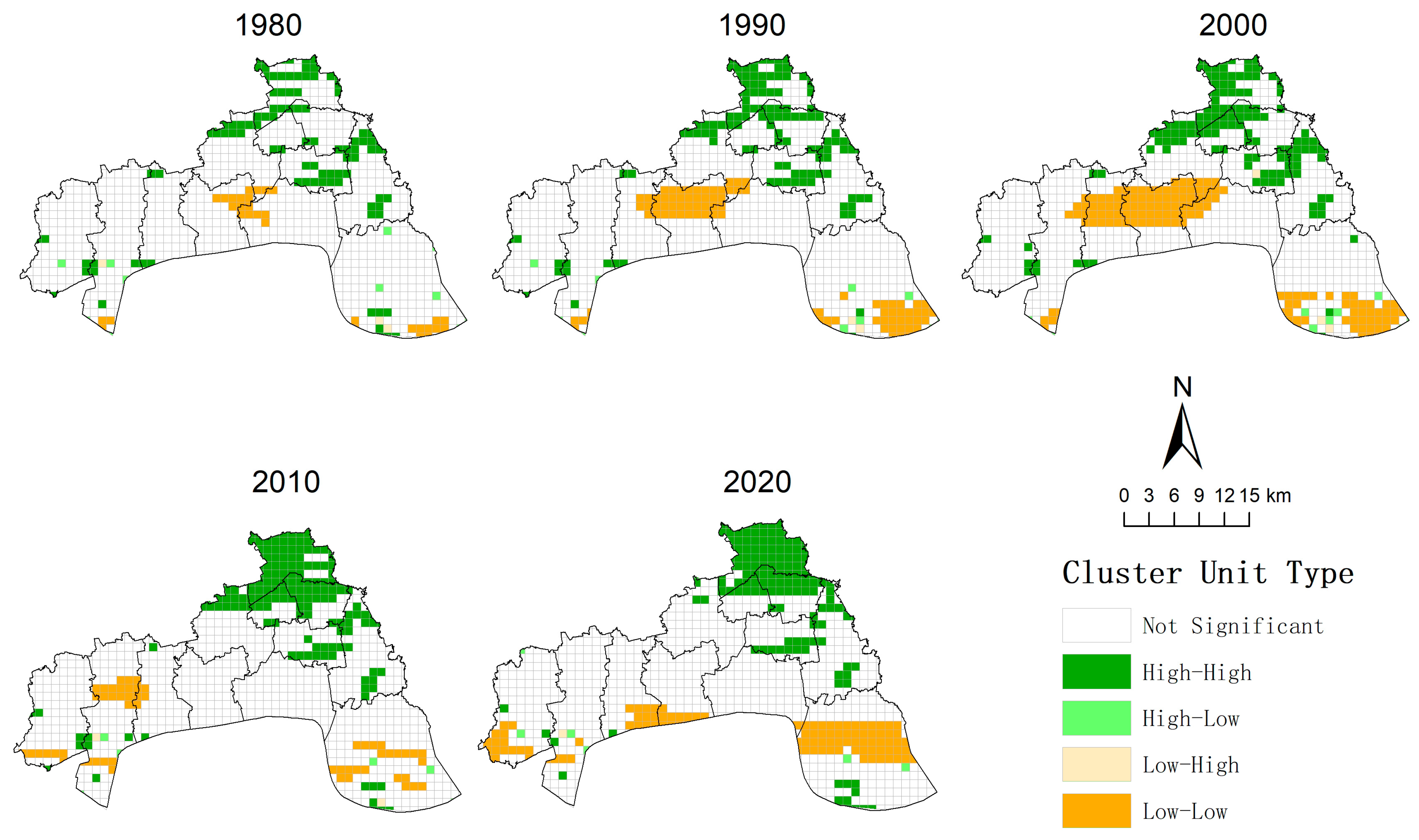

| Land Use Type | 1980 | 1990 | 2000 | 2010 | 2020 | |||||
|---|---|---|---|---|---|---|---|---|---|---|
| Area/ha | Percentage/% | Area/ha | Percentage/% | Area/ha | Percentage/% | Area/ha | Percentage/% | Area/ha | Percentage/% | |
| Farmland | 524.13 | 60.42 | 528.64 | 60.94 | 510.64 | 58.86 | 496.77 | 57.27 | 427.65 | 49.30 |
| Woodland | 11.18 | 1.29 | 12.80 | 1.48 | 12.48 | 1.44 | 13.22 | 1.52 | 12.46 | 1.44 |
| Grassland | 28.24 | 3.26 | 0.36 | 0.04 | 0.33 | 0.04 | 0.33 | 0.04 | 8.66 | 1.00 |
| Waters | 155.41 | 17.91 | 186.15 | 21.46 | 190.21 | 21.93 | 157.47 | 18.15 | 154.91 | 17.86 |
| Urban and Rural Residential Land | 143.71 | 16.57 | 137.46 | 15.85 | 151.48 | 17.46 | 187.30 | 21.59 | 246.59 | 28.43 |
| Industrial and Mining Land | 4.82 | 0.56 | 2.02 | 0.23 | 2.34 | 0.27 | 12.40 | 1.43 | 17.22 | 1.99 |
| unused land | 0 | 0 | 0.04 | 0.004 | 0 | 0 | 0 | 0 | 0 | 0 |
Disclaimer/Publisher’s Note: The statements, opinions and data contained in all publications are solely those of the individual author(s) and contributor(s) and not of MDPI and/or the editor(s). MDPI and/or the editor(s) disclaim responsibility for any injury to people or property resulting from any ideas, methods, instructions or products referred to in the content. |
© 2025 by the authors. Licensee MDPI, Basel, Switzerland. This article is an open access article distributed under the terms and conditions of the Creative Commons Attribution (CC BY) license (https://creativecommons.org/licenses/by/4.0/).
Share and Cite
Zhang, W.; Du, C.; Shi, Y.; Liu, X. Study on the Evolution of Landscape Patterns in Industrial Cities Based on the Evaluation of Ecological Security Levels—A Case Study of Haining City. Sustainability 2025, 17, 9539. https://doi.org/10.3390/su17219539
Zhang W, Du C, Shi Y, Liu X. Study on the Evolution of Landscape Patterns in Industrial Cities Based on the Evaluation of Ecological Security Levels—A Case Study of Haining City. Sustainability. 2025; 17(21):9539. https://doi.org/10.3390/su17219539
Chicago/Turabian StyleZhang, Wei, Chenqin Du, Yu Shi, and Xuewen Liu. 2025. "Study on the Evolution of Landscape Patterns in Industrial Cities Based on the Evaluation of Ecological Security Levels—A Case Study of Haining City" Sustainability 17, no. 21: 9539. https://doi.org/10.3390/su17219539
APA StyleZhang, W., Du, C., Shi, Y., & Liu, X. (2025). Study on the Evolution of Landscape Patterns in Industrial Cities Based on the Evaluation of Ecological Security Levels—A Case Study of Haining City. Sustainability, 17(21), 9539. https://doi.org/10.3390/su17219539






